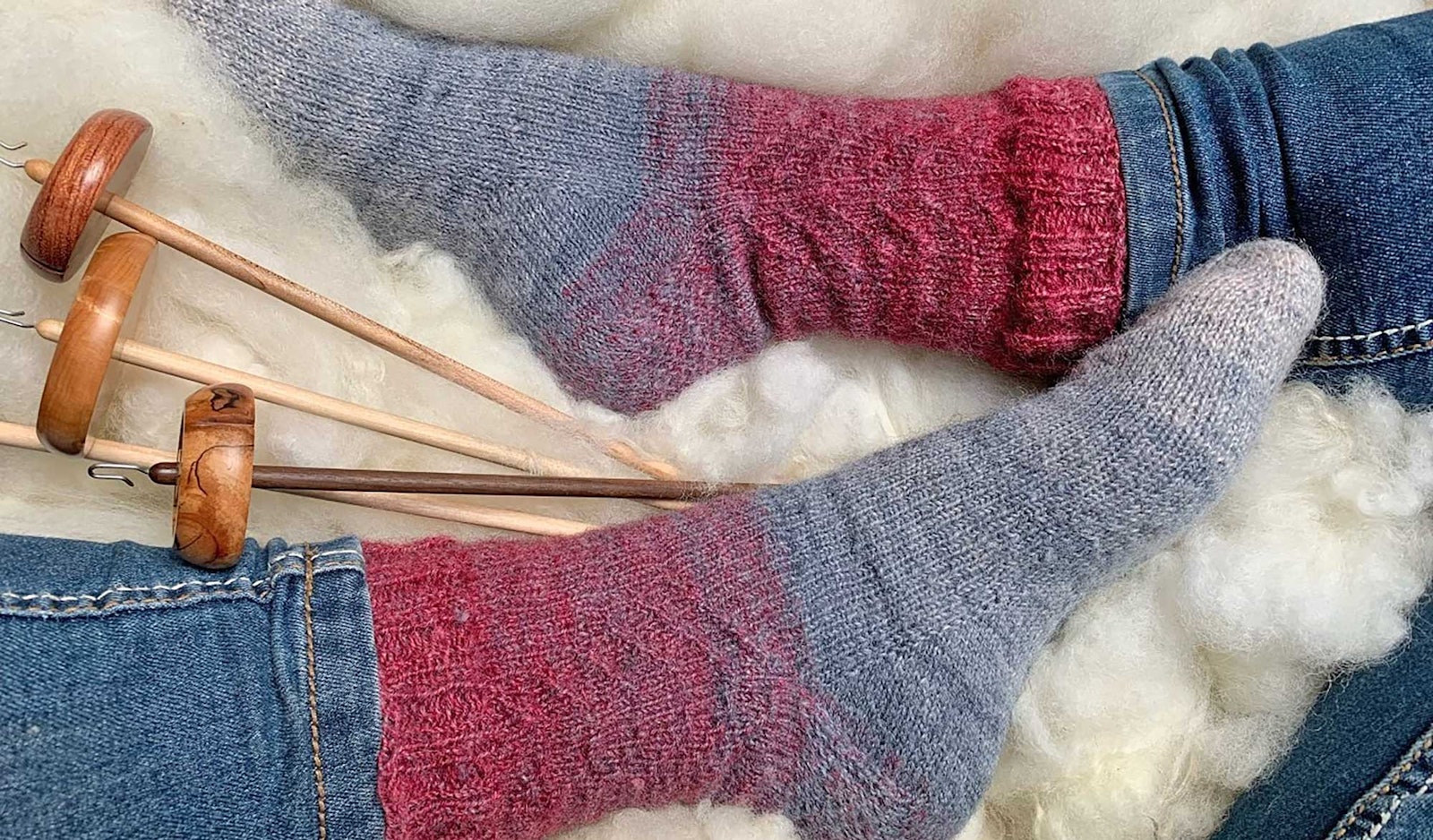Pattern and designer Frasier Fir by Verena Cohrs.
Fiber East Friesian fleece dyed in two colors.
Preparation Minibatts created on a blending board.
Wheel system/spindle For the singles: Bosworth top-whorl spindles. For plying: Thomas Walther “Anna” double-treadle scotch-tension wheel.
Ratio 14:1.
Drafting method Short draw.
Singles direction Z-spun.
Singles wraps per inch 27.
Ply wraps per inch 15–16.
Total yardage 418 yards (6 1/3 ounces).
Yards per pound 1,067 yards.
Yarn classification/weight Laceweight, but as it is so dense, it’s good for socks typically knitted in fingering-weight yarn.
Yardage used 273 yards (4 ounces).
Needles Size 1 (2.25 mm) double-pointed needles.
Gauge 32 stitches and 44 rounds = 4" in St st.
Finished size German size 39.5 (US size 6).
In the spring of 2021, I received half of an East Friesian milk sheep fleece from a dear fellow spinner. When people talk about spinning for socks, the suggested fibers are usually blends of superwash wool with nylon or silk. But I remembered that my first order of milk sheep indicated: “hardly ever felts; good for socks.” I contemplated spinning a three-ply yarn with more plying twist than needed to result in a sturdy sock yarn that I could use in walking boots and also place in my washing machine without fear of felting or shrinking.
I cleansed the fleece with not much effort—it wasn’t very greasy—and the clean, wavy locks rewarded me with a nice white that offered some luster in bright daylight. I dyed some parts of the fleece in jeans blue and some in a Bordeaux red. I used my blending board to card the white, blue, and red locks but also to mix white with blue, white with red, and red with blue. To mix colors on my blending board, I first applied both colors alternately in thin layers. I removed the fiber and then reapplied it to the cloth to create a homogeneous mix. I made two batts of about 15 grams for each of the six shades. This would allow me to use one batt per color as I spun two skeins, one for each sock.
 The author’s carefully planned color progression plays out nicely in her finished sock design.
The author’s carefully planned color progression plays out nicely in her finished sock design.
Next, I prepared my colors so I could spin three singles for a final three-ply sock yarn. I like yarns with slow and smooth color progressions and decided to try staggered colors in the singles to create smooth transitions (see color chart below). The first singles started with the complete portion of white, blending into light red, red, purple, blue, and light blue. The second singles started with just two-thirds of white, continued with the same light red to light blue portions, and ended with the last third of white. And the third singles started with one-third of white, and so on.

Plying was tricky. I overplied the yarn to make it sturdier, pressing as much air out of it as possible. But I had to watch my three spindles while decreasing their load to see if the colors really changed as intended. I was lucky that it was necessary only three times to remove some yards of a singles from one spindle to keep the color sequence correct. The same happened while knitting: To keep the second sock nearly similar, I had to remove some of the blue yarn.
Verena Cohrs’s toe-up Frasier Fir was perfect for showing the color progression by offering a strong heel and the nice tree of twisted stitches on the leg. And the toe-up construction allows you to stop at the length of the leg and cuff you like. When I used the small needle size that was recommended, this dense yarn made my hand hurt after knitting for more than an hour or so. Going up one needle size felt better and still resulted in the stiff finished fabric I had in mind when planning these socks.
 Beate models her finished socks.
Beate models her finished socks.
In the end, I am a bit sorry that I had spun a little too much of each color, resulting in more yards than needed. So, my finished socks only contain light blue to red, missing the light red and white parts (which I used to knit a smaller pair for my toddler grandchild). When I perhaps repeat this kind of spinning for socks, I will reduce the total amount per skein a bit.
Beate Fischer started knitting as a child at her grandmother’s house and learned to spin on a spinning wheel more than a decade ago. Since 2020, she cannot leave the house without a drop spindle and fiber. She favors knitting color-stranded gloves using small amounts of spindle-spun yarns. In her fiberless life, she’s a professional IT analyst, single-malt Scotch and sushi lover, and proud grandma of two toddlers. Find her on Ravelry as Batbetty.
Have a finished object to share? Tell us about it! Contact [email protected] to submit your project.

